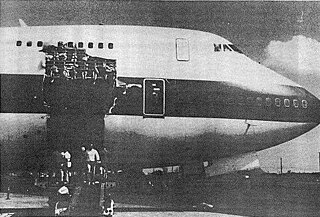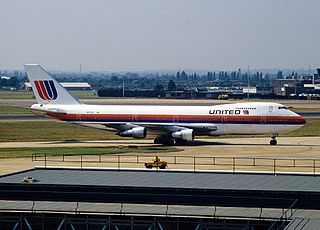
KLM Royal Dutch Airlines, legally Koninklijke Luchtvaart Maatschappij N.V., is the flag carrier of the Netherlands. KLM is headquartered in Amstelveen, with its hub at nearby Amsterdam Airport Schiphol. It is a subsidiary of the Air France–KLM group and a member of the SkyTeam airline alliance. Founded in 1919, KLM is the oldest operating airline in the world, and has 35,488 employees with a fleet of 110 as of 2021. KLM operates scheduled passenger and cargo services to 145 destinations.

Executive Decision is a 1996 American action thriller film directed by Stuart Baird in his directorial debut. It stars Kurt Russell, Steven Seagal, Halle Berry, John Leguizamo, Oliver Platt, Joe Morton, David Suchet and B.D. Wong. It depicts the rescue of an airliner hijacked by terrorists, by a small team placed on the plane in mid-flight. The film was released in the United States on March 15, 1996 and grossed $122 million against a $55 million budget.

The Tenerife airport disaster occurred on March 27, 1977, when two Boeing 747 passenger jets collided on the runway at Los Rodeos Airport on the Spanish island of Tenerife. The collision occurred when KLM Flight 4805 initiated its takeoff run during dense fog while Pan Am Flight 1736 was still on the runway. The impact and resulting fire killed everyone on board KLM 4805 and most of the occupants of Pan Am 1736, with only 61 survivors in the front section of the aircraft, resulting in the worst aviation disaster in Spain. With 583 fatalities, the disaster is also the deadliest accident in aviation history.

Northwest Airlines Corp. was a major airline in the United States that operated from 1926 until 2010, when it merged with Delta Air Lines. The merger made Delta the largest airline in the world until the American Airlines–US Airways merger in 2013.

On July 23, 1999, an All Nippon Airways Boeing 747-481D with 503 passengers on Flight 61, including 14 children and 14 crew members on board, took off from Tokyo Haneda Airport in Ōta, Tokyo, Japan and was en route to New Chitose Airport in Chitose, Japan, near Sapporo when it was hijacked by Yūji Nishizawa.

Philippine Airlines Flight 434, sometimes referred to as PAL434 or PR434, was a flight on December 11, 1994, from Cebu to Tokyo on a Boeing 747-283B that was seriously damaged by a bomb, killing one passenger and damaging vital control systems, although the plane was in a repairable state. The bombing was a test run of the unsuccessful Bojinka terrorist attacks. The Boeing 747 was flying the second leg of a route from Ninoy Aquino International Airport, Pasay in the Philippines, to Narita International Airport, in Tokyo, Japan, with a stop at Mactan–Cebu International Airport, Cebu, in the Philippines. After the bomb detonated, 58-year-old veteran pilot Captain Eduardo "Ed" Reyes was able to land the aircraft, saving it and the remaining passengers and crew.

Japan Air Lines Flight 123 was a scheduled domestic passenger flight from Tokyo to Osaka, Japan. On August 12, 1985, the Boeing 747 operating the service suffered a severe structural failure and decompression 12 minutes into the flight. After flying under minimal control for a further 32 minutes, the 747 crashed in the area of Mount Takamagahara, 100 kilometres from Tokyo.

Air India Flight 855 was a scheduled passenger flight from Bombay, India, to Dubai, United Arab Emirates. On 1 January 1978, the Boeing 747 operating the flight crashed about 3 km off the coast of Bandra, less than two minutes after take-off. All 213 passengers and crew on board died. An investigation into the crash determined the most likely probable cause was the captain becoming spatially disoriented and losing control of the aircraft after the failure of one of the flight instruments. It was the deadliest air accident both in Air India's and India's history until Flight 182 in 1985 and then Charkhi Dadri mid-air collision in 1996.

Oceanic Airlines, and less frequently, Oceanic Airways, is the name of a fictional airline used in several films, television programs, and comic books—typically works that feature plane crashes and other aviation disasters, with which a real airline would prefer not to be associated.

United Airlines Flight 811 was a regularly scheduled airline flight from Los Angeles to Sydney, with intermediate stops at Honolulu and Auckland. On February 24, 1989, the Boeing 747-122 serving the flight experienced a cargo-door failure in flight shortly after leaving Honolulu. The resulting explosive decompression blew out several rows of seats, killing nine passengers. The aircraft returned to Honolulu and landed with no further incident.

Singapore Airlines Flight 006 was a scheduled Singapore Airlines passenger flight from Singapore Changi Airport to Los Angeles International Airport via Chiang Kai-shek International Airport near Taipei, Taiwan. On 31 October 2000, at 23:18 Taipei local time, the Boeing 747-412 operating the flight attempted to take off from the wrong runway at Chiang Kai-shek International Airport during a typhoon. The aircraft crashed into construction equipment on the runway, killing 83 of the 179 people aboard. Ninety-eight occupants initially survived the accident, but two passengers died later from injuries in hospital. It was the first fatal accident involving a Boeing 747-400; it is also the first Singapore Airlines accident to result in fatalities.

On December 28, 1997, United Airlines Flight 826 was operated by a Boeing 747-100 flying from New Tokyo Airport, Japan to Honolulu International Airport, Hawaii. Two hours into the flight, at an altitude of 31,000 feet (9,400 m), the plane received reports of severe clear-air turbulence in the area and the seat belt sign was turned on. Moments later, the aircraft suddenly dropped around 100 feet (30 m), seriously injuring 15 passengers and 3 crew members. The plane turned around and landed safely back in Tokyo, but one passenger, a 32-year-old Japanese woman, died.

Jacob Louis Veldhuyzen van Zanten was a Dutch aircraft captain and flight instructor. He was captain of the KLM Flight 4805 and died in the Tenerife airport disaster, the deadliest accident in aviation history. He was KLM's chief instructor and commonly appeared on advertising.

As of July 2020, a total of 60 Boeing 747 aircraft, or just under 4% of the total number of 747s built, first flown commercially in 1970, have been involved in accidents and incidents resulting in a hull loss, meaning that the aircraft was either destroyed or damaged beyond economical repair. Of the 60 Boeing 747 aircraft losses, 32 resulted in no loss of life; in one, a hostage was murdered; and in one, a terrorist died. Some of the aircraft that were declared damaged beyond economical repair were older 747s that sustained relatively minor damage. Had these planes been newer, repairing them might have been economically viable, although with the 747's increasing obsolescence, this is becoming less common. Some 747s have been involved in accidents resulting in the highest death toll of any civil aviation accident, the highest death toll of any single airplane accident, and the highest death toll of a midair collision. As with most airliner accidents, the root of cause(s) in these incidents involved a confluence of multiple factors that rarely could be ascribed to flaws with the 747's design or its flying characteristics.

Sonic Impact is a 2000 action/thriller directed by Rodney McDonald and starring James Russo, Mel Harris, Michael Harris and Ice-T, with Michael Raynor.

Korean Air Flight 801 was a scheduled international passenger flight operated by Korean Air, from Gimpo International Airport, Seoul to Antonio B. Won Pat International Airport, Guam. On August 6, 1997, the Boeing 747-300 operating the flight crashed on Bijia Peak, south of Nimitz Hill, in Asan-Maina, Guam, while on approach to Antonio B. Won Pat International Airport, in the United States territory of Guam, killing 229 of the 254 people aboard.

On 4 October 1992, El Al Flight 1862, a Boeing 747 cargo aircraft of the Israeli airline El Al, crashed into the Groeneveen and Klein-Kruitberg flats in the Bijlmermeer neighbourhood of Amsterdam, the Netherlands. The crash is known in Dutch as the Bijlmerramp.

British Airways Flight 2069 was a scheduled passenger flight operated by British Airways between Gatwick, England and Jomo Kenyatta Airport, Nairobi, Kenya. At 05:00 on 29 December 2000, a mentally ill passenger stormed the cockpit and attempted to hijack the aircraft. The 747 stalled in the struggle. Captain William Hagan and his crew were able to apprehend the assailant while first officer Phil Watson regained control of the aircraft, bringing the situation under control.
Maria Ziadie-Haddad is an airline pilot from Jamaica. She was the first woman commercial pilot hired by Air Jamaica and upon obtaining her qualifications as a captain became Air Jamaica's first woman captain. When the government divested its holding in the firm, Ziadie Haddad began flying commercial freight in the United States.
















